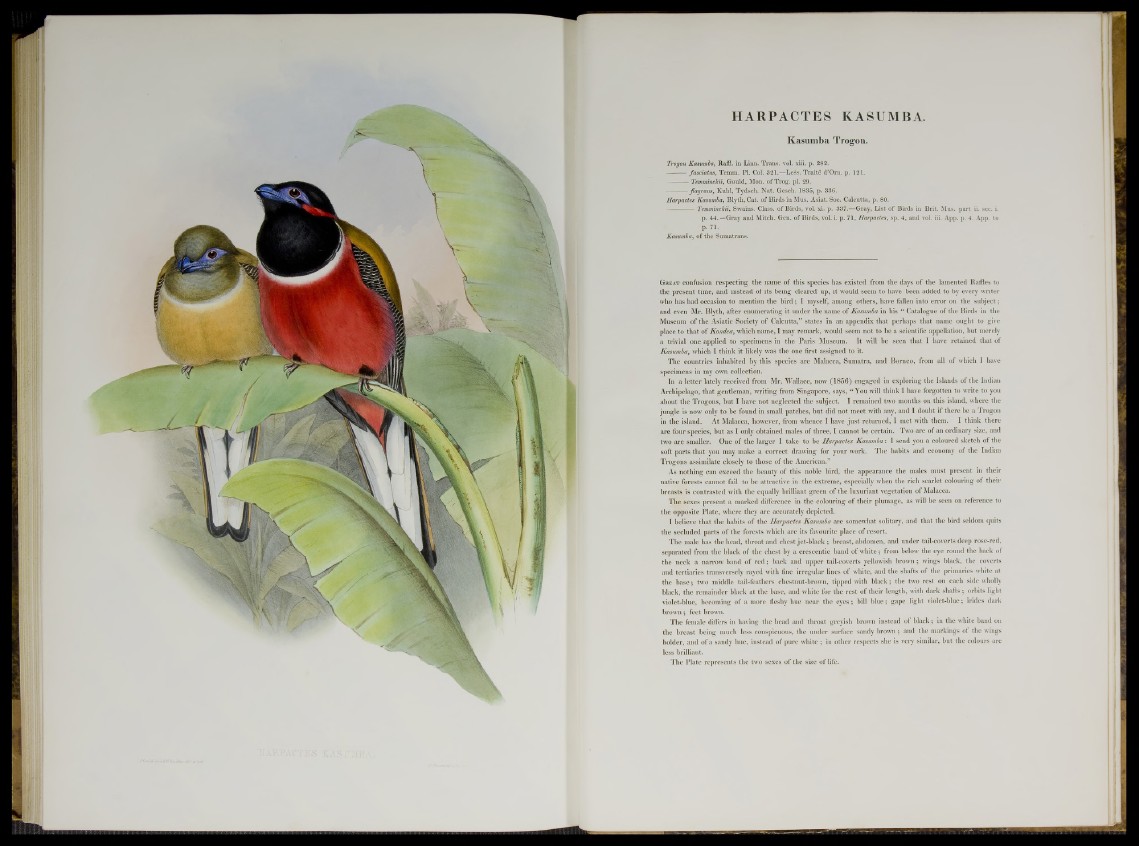
Kasumba Trognon.
Trogon Kasumba, Raffl. in Linn. Trans, vol. xiii. p. 282.
fasciatus, Temm. PI. Col. 321.—Less. Traité d’Orn. p. 121.
TemmincJcii, Gould, Mon. of Trog. pi. 29.
— jlagrans, Kuhl, Tydsch. Nat. Gesch. 1835, p. 336.
Harpactes Kasumba, Blyth, Cat. of Birds in Mus. Asiat. Soc. Calcutta, p. 80.
— TemmincJcii, Swains. Class, of Birds, vol. xi. p. 337.—Gray, List of Birds in Brit. Mus. part ii. sec. i.
p. 44 .—Gray and Mitch. Gen. of Birds, vol. i. p. 71, Harpactes, sp. 4, and vol. iii. App. p. 4. App. to
p. 71.
Kasumba, of the Sumatrans.
G reat confusion respecting the name of this species has existed from the days of the lamented Raffles to
the present time, and instead of its being cleared up, it would seem to have been added to by every writer
who has had occasion to mention the bird; I myself, among others, have fallen into error on the subject;
and even Mr. Blyth, after enumerating it under the name of Kasumba in his “ Catalogue of the Birds in the
Museum of the Asiatic Society of Calcutta,” states in an appendix that perhaps that name ought to give
place to that of Kondea, which name, I may remark, would seem not to be a scientific appellation, but merely
a trivial one applied to specimens in the Paris Museum. It will be seen that I have retained that of
Kasumba, which I think it likely was the one first assigned to it.
The countries inhabited by this species are Malacca, Sumatra, and Borneo, from all of which I have
specimens in my own collection.
In a letter lately received from Mr. Wallace, now (1856) engaged in exploring the Islands of the Indian
Archipelago, that gentleman, writing from Singapore, says, “ You will think I have forgotten to write to you
. about the Trogons, but I have not neglected the subject. I remained two months on this island, where the
jungle is now only to he found in small patches, but did not meet with any, and I doubt if there be a Trogon
in the island. At Malacca, however, from whence I have just returned, I met with them. I think there
are four species, hut as I only obtained males of three, I cannot be certain. Two are of an ordinary size, and
two are smaller. One of the larger I take to be Harpactes Kasumba: I send you a coloured sketch of the
soft parts that you may make a correct drawing for your work. The habits and economy of the Indiau
Trogons assimilate closely to those of the American.”
As nothing can exceed the beauty of this noble bird, the appearance the males must present in their
native forests cannot fail to be attractive in the extreme, especially when the rich scarlet colouring of their
breasts is contrasted with the equally brilliant green of the luxuriant vegetation of Malacca.
The sexes present a marked difference in the colouring of their plumage, as will be seen on reference to
the opposite Plate, where they are accurately depicted.
I believe that the habits of the Harpactes Kasumba are somewhat solitary, and that the bird seldom quits
the secluded parts of the forests which are its favourite place of resort.
The male has the head, throat and chest jet-black ; breast, abdomen, and under tail-coverts deep rose-red,
separated from the black of the chest by a crescentic band of white; from below the eye round the back of
the neck a narrow band of red; back and upper tail-coverts yellowish brown ; wings black, the coverts
and tertiaries transversely rayed with fine irregular lines of white, and the shafts of the primaries white at
the base; two middle tail-feathers chestnut-brown, tipped with black; the two rest on each side wholly
black, the remainder black at the base, and white for the rest of their length, with dark shafts; orbits light
violet-blue, becoming of a more fleshy hue near the eyes; bill blue; gape light violet-blue; irides dark
brown; feet brown.
The female differs in having the head and throat greyish brown instead of black; in the white band on
the breast being much less conspicuous, the under surface sandy brown ; and the markings of the wings
bolder, and of a sandy hue, instead of pure white ; in other respects she is very similar, but the colours are
less brilliant.
The Plate represents the two sexes of the size of life.